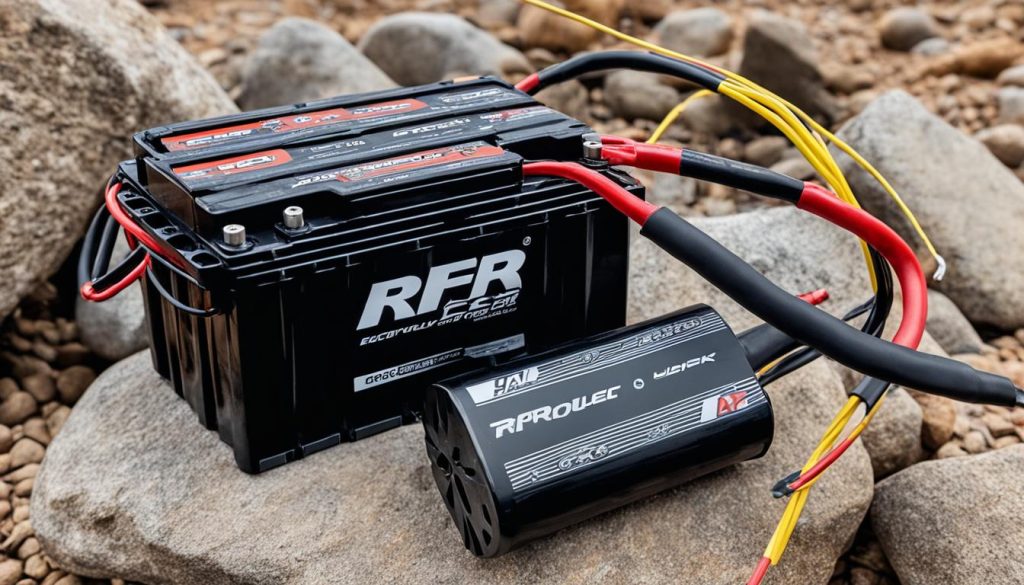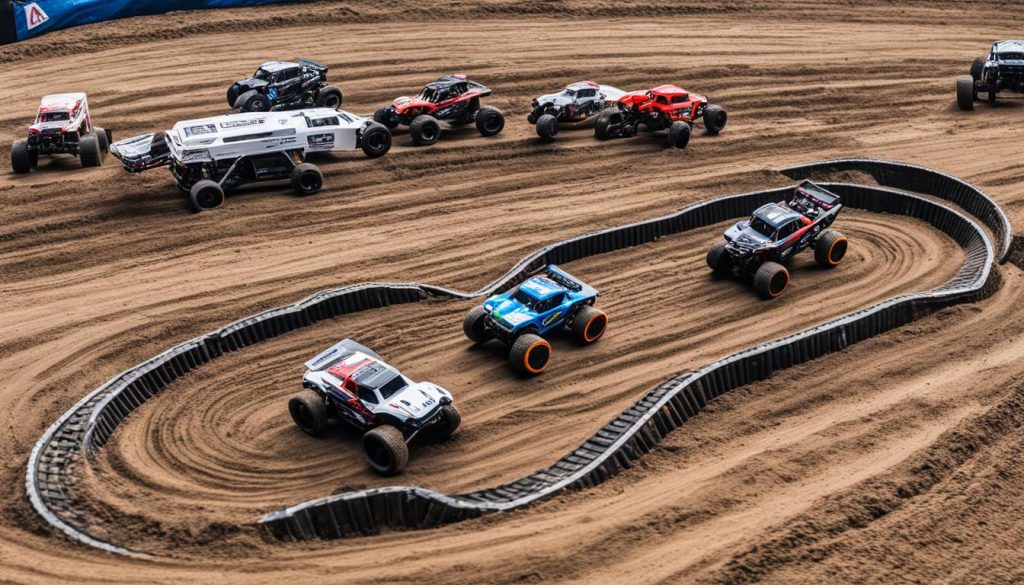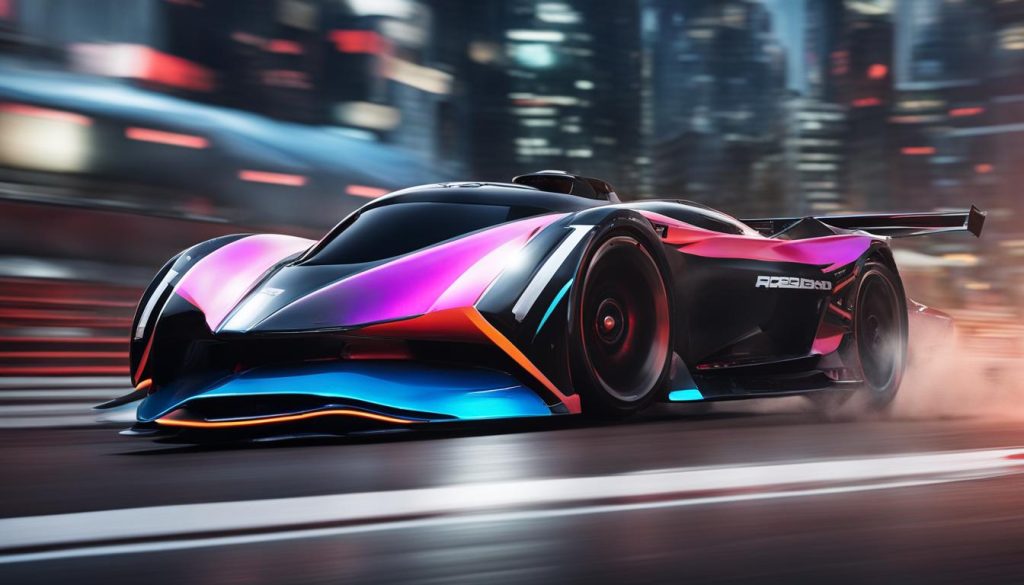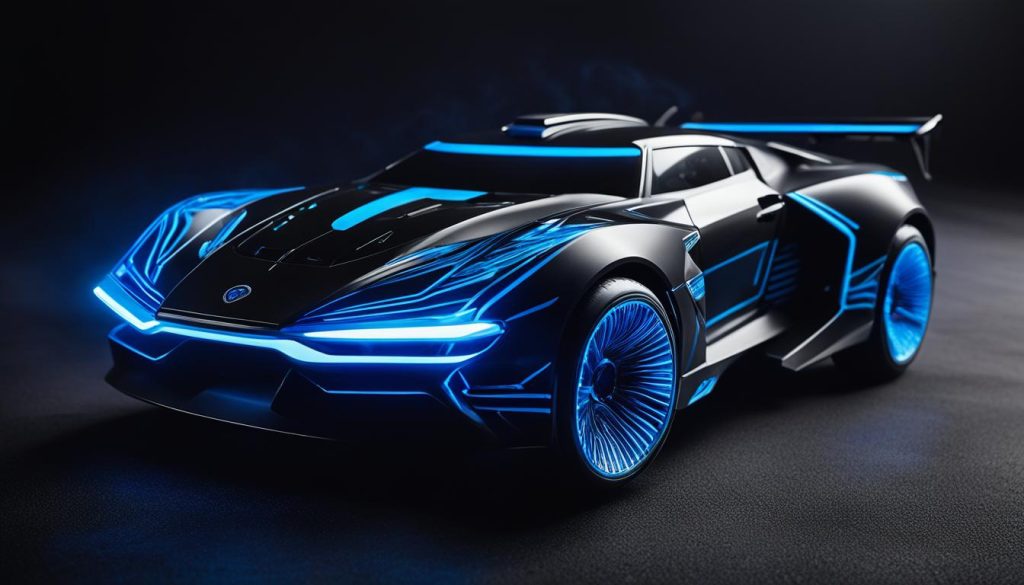Are you looking to take your off-road RC car to the next level? One simple and effective way to enhance its performance is by upgrading the batteries. Whether you’re a seasoned RC enthusiast or just starting out, these battery upgrade tips will help you improve the overall power and longevity of your RC car.
Upgrading your off-road RC car batteries can provide several benefits. Not only will you experience increased performance, but you’ll also be able to enjoy longer drives, allowing you to maximize the fun and excitement of your RC car adventures. To ensure you make the most out of your battery upgrade, it’s important to consider factors such as battery type, capacity, and voltage. Let’s dive deeper into each aspect to guide you through the process.
Key Takeaways:
- Upgrade the batteries in your off-road RC car for improved performance and longer drives.
- Understanding battery C rating is crucial for choosing the right batteries.
- Consider the compatibility and advantages of NiMH and LiPo batteries.
- Check your RC car’s owner’s manual for recommended battery capacity and voltage.
- Explore higher capacity NiMH batteries or LiPo battery conversion for longer run times.
Understanding Battery C Rating
When it comes to RC car batteries, understanding the C rating is essential for optimizing performance. The C rating refers to the battery’s ability to deliver current within a specific time period. In simple terms, a higher C rating means the battery can deliver more current, resulting in faster charging and increased power output for your RC car.
Choosing the right C rating is crucial for ensuring your RC car operates at its best. It is recommended to purchase batteries with at least the same C rating as the ones supplied by the manufacturer. By doing so, you can ensure that the battery can meet the demands of your RC car’s power system and deliver optimal performance.
Higher C ratings provide additional headroom for the battery’s current delivery ability, allowing it to handle bursts of high current more efficiently. This not only improves overall power output but also helps prevent excessive strain on the battery, which can lead to longer battery life.
The Impact of Battery C Rating
The C rating directly affects the battery’s ability to handle the current demands of your RC car. A battery with a lower C rating may struggle to keep up with the power demands, resulting in slower acceleration and reduced overall performance.
“A higher C rating means better power delivery, faster charging, and improved performance for your RC car.”
When considering battery upgrades, it’s important to choose batteries with an appropriate C rating for your RC car’s specific power requirements. Failure to do so may result in suboptimal performance, reduced power output, and potentially even damage to the battery or RC car’s electronics.
Image:
Choosing the Right Battery Type
When upgrading the batteries in your RC car, one of the key considerations is choosing the right battery type. The two main options available for RC cars are NiMH (Nickel-Metal Hydride) batteries and LiPo (Lithium Polymer) batteries.
NiMH batteries are a popular choice for beginners and budget-conscious enthusiasts. They are generally cheaper than LiPo batteries and offer easier charging and storage. NiMH batteries are also known for their durability and are less prone to overheating compared to LiPo batteries.
“NiMH batteries are more beginner-friendly, cheaper, and easier to charge and store.”
On the other hand, LiPo batteries are the go-to option for experienced RC car enthusiasts who prioritize performance. LiPo batteries offer higher power output, longer-lasting power, and a better weight-to-power ratio. They are lighter and more compact, allowing for better weight distribution in RC cars, which can result in improved handling and maneuverability on the track.
“LiPo batteries offer higher performance, longer-lasting power, and a better weight-to-power ratio.”
To determine which battery type is compatible with your RC car, it’s essential to consult the owner’s manual or manufacturer’s specifications. The compatibility between RC cars and batteries can vary, so it’s crucial to follow the recommendations provided.
If you’re looking to take your RC car’s performance to the next level, consider upgrading to LiPo batteries. The enhanced power and longevity that LiPo batteries offer can significantly improve your RC car’s speed, acceleration, and overall performance. Just be sure to check if your RC car’s electronics and components are compatible with the higher voltage and power demands of LiPo batteries.
Remember, choosing the right battery type is a crucial step in upgrading your RC car’s performance. Whether you opt for the reliability and affordability of NiMH batteries or the high performance and power of LiPo batteries, selecting the right battery type can make a significant difference in your RC car’s performance on the track.
Consider Battery Capacity and Voltage
When it comes to upgrading your off-road RC car batteries, it’s essential to consider both battery capacity and voltage. These two factors play a crucial role in determining the run time and power output of your RC car, ultimately impacting its overall performance.
The capacity of an RC battery is measured in milliampere-hours (mAh) and represents the amount of charge it can hold. Higher mAh ratings indicate larger capacity, which translates to longer run times. So, if you’re looking for extended driving sessions without having to recharge frequently, opting for batteries with higher capacity is the way to go. You’ll be able to enjoy more uninterrupted playtime with your RC car.
On the other hand, voltage is responsible for determining the power output and RPM (revolutions per minute) of your RC car. Higher voltage batteries can provide more power to the motor, resulting in increased speed and acceleration. However, it’s crucial to check the compatibility of your RC car with different voltage levels. Consult your owner’s manual or do some research to determine the maximum voltage your RC car can handle.
Choosing the right battery capacity and voltage for your RC car is crucial to ensure optimal performance and avoid damaging your vehicle. Refer to your owner’s manual or contact the manufacturer for specific recommendations tailored to your RC car model.
By understanding the importance of battery capacity and voltage, you can make informed decisions when upgrading your RC car batteries. Achieve longer run times and unleash the full power potential of your off-road RC car by selecting batteries with the appropriate capacity and voltage.
Upgrading to Higher Capacity Batteries
If you’re looking to maximize the run times of your off-road RC car, upgrading to batteries with higher capacity can significantly enhance its performance. Whether you prefer NiMH batteries or consider converting to LiPo batteries, there are options available to meet your specific needs.
Upgrading NiMH Batteries
If you currently use NiMH batteries, you can find options with higher milliampere-hour (mAh) ratings that offer extended power output. These higher-capacity NiMH batteries allow for longer playtime and increased drive time, providing you with extended fun on the track or off-road.
Converting to LiPo Batteries
If your RC car is compatible, converting to LiPo batteries can take your performance to a whole new level. LiPo batteries offer even better power output, enhanced speed, and longer-lasting power compared to NiMH batteries. Their lightweight design and higher energy density make them ideal for off-road RC cars seeking optimum performance.
Before converting to LiPo batteries, ensure that your RC car’s electronics and speed controller can handle the different voltage characteristics of LiPo batteries. Additionally, check if the physical dimensions of the LiPo batteries fit within the battery compartment of your RC car.
| Battery Type | Pros | Cons |
|---|---|---|
| NiMH Batteries |
|
|
| LiPo Batteries |
|
|
When upgrading to higher capacity batteries, always consider your RC car’s specifications and requirements. Be sure to follow the manufacturer’s recommendations and guidelines to optimize the performance and safety of your RC car.
https://www.youtube.com/watch?v=6hfKoihjumo
By upgrading to higher capacity batteries, you’ll enjoy extended run times and enhanced performance during your off-road adventures. Whether you choose higher-capacity NiMH batteries or make the exciting conversion to LiPo batteries, your RC car will benefit from increased power output and longer-lasting fun on the track.
Ensuring Safety with Battery Upgrades
When upgrading your RC car batteries, it’s important to prioritize RC battery safety. Some battery upgrades may require additional safety measures to prevent potential hazards and ensure optimal performance. One crucial safety feature to consider is a low voltage cutoff (LVC) system, which prevents over-discharging the battery.
The low voltage cutoff (LVC) is a mechanism that automatically stops the RC car’s motor when the battery voltage drops below a certain threshold. This prevents damaging the battery by discharging it too much, prolonging its lifespan. You can think of it as a safety net that helps protect your battery investment.
Additionally, it’s recommended to install external protection devices like LVC alarms or cutoffs to ensure safe and reliable battery performance. These devices provide an added layer of defense against over-discharging and help you monitor the battery voltage in real-time. In the event that the voltage drops too low, the alarm will sound or the cutoff will activate, alerting you to take necessary action.
Remember, safety should always be a top priority when working with RC car batteries. By implementing appropriate safety measures like a low voltage cutoff and external protection devices, you can enjoy your RC car adventures with peace of mind.
| RC Battery Safety Checklist |
|---|
| Install a low voltage cutoff system |
| Use external protection devices like LVC alarms or cutoffs |
| Regularly monitor battery voltage |
| Familiarize yourself with the manufacturer’s safety guidelines |
| Store and transport batteries in proper containers |
| Keep batteries away from heat sources and direct sunlight |
| Dispose of old or damaged batteries responsibly |
Key Points:
- Prioritize safety when upgrading RC car batteries
- Consider installing a low voltage cutoff (LVC) system
- Use external protection devices like LVC alarms or cutoffs
- Regularly monitor battery voltage and follow safety guidelines
Improving Motor Performance
When it comes to enhancing the performance of your RC car, upgrading your batteries is just one piece of the puzzle. Another crucial aspect to consider is optimizing your motor performance. By making a few adjustments, such as gearing down and using a smaller pinion, you can significantly improve the efficiency of your motor, resulting in better acceleration and a longer motor life.
Gearing Down
Gearing down your RC car involves using a smaller pinion, which refers to the gear attached to the motor shaft. This adjustment reduces the overall gear ratio between the motor and the wheels, providing numerous benefits for your RC car’s motor. By decreasing the gear ratio, you effectively reduce the strain on the motor, allowing it to operate more efficiently.
A smaller pinion can improve performance by:
- Reducing the load on the motor, preventing overheating and excessive wear.
- Increasing the torque output, resulting in better acceleration and climbing ability.
- Improving overall motor efficiency, leading to increased power and longer battery life.
Example:
“Gearing down my RC car was a game-changer! The smaller pinion significantly improved the acceleration and overall performance. I noticed a remarkable difference in how efficiently the motor operated, and it even extended the runtime of my battery. It’s definitely a modification that any RC car enthusiast should consider.” – John, RC car enthusiast
Visual Representation of Gearing Down:
| Before Gearing Down | After Gearing Down |
|---|---|
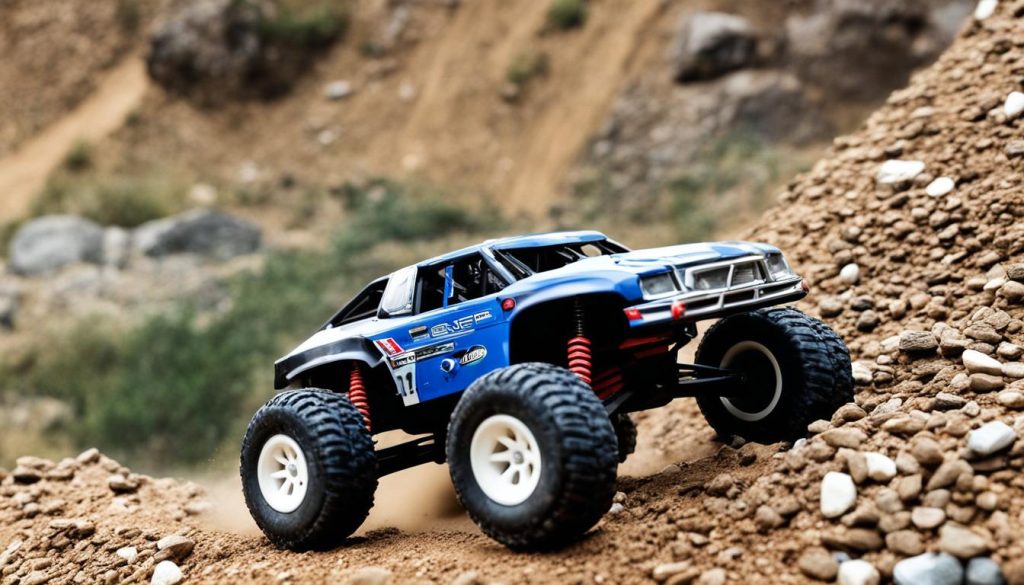 |
Gearing down your RC car’s motor is a simple yet effective way to optimize its performance. By using a smaller pinion, you can minimize strain, increase efficiency, and enjoy better acceleration. Don’t forget to consult your RC car’s manual or seek advice from experienced enthusiasts to ensure you select the appropriate pinion size for your specific model.
Exploring Brushless Motor Upgrades
Looking to take your off-road RC car to the next level of performance? Consider upgrading your brushed motor to a brushless motor. Brushless motors offer a range of benefits that can significantly enhance your RC car’s power, efficiency, and overall performance. With improved brushless motor technology, you can enjoy increased power output, longer run times, and enhanced durability.
One of the key advantages of brushless motors is their higher power output. Unlike brushed motors, which rely on physical brushes for the transfer of electricity, brushless motors utilize advanced electronic control systems. This allows brushless motors to deliver more power to your RC car’s wheels, resulting in faster acceleration and improved speed on off-road terrains.
Additionally, brushless motors are known for their increased efficiency. The absence of brushes reduces friction, minimizing power loss and heat generation. As a result, brushless motors operate more efficiently, allowing your RC car to achieve longer run times and better battery life. With the improved efficiency of a brushless motor, you can enjoy extended play sessions without worrying about battery drainage.
Another significant advantage of brushless motors is their compatibility with LiPo (Lithium Polymer) batteries. LiPo batteries offer a higher energy density compared to traditional NiMH (Nickel-Metal Hydride) batteries. When combined with a brushless motor, LiPo batteries can provide even more power and longer run times, taking your off-road RC car’s performance to new heights.
To demonstrate the benefits of a brushless motor upgrade, consider the following table:
| Motor Type | Power Output | Efficiency | Run Time |
|---|---|---|---|
| Brushed Motor | High | Lower | Shorter |
| Brushless Motor | Higher | Higher | Longer |
As shown in the table, brushless motors offer increased power output, higher efficiency, and longer run times compared to brushed motors. These advantages make brushless motor upgrades a worthwhile investment for off-road RC car enthusiasts looking to maximize their driving experience.
When considering a brushless motor upgrade, it is important to ensure compatibility with your RC car’s electronics and drivetrain. Check your RC car’s owner’s manual or consult with a knowledgeable RC car hobbyist to determine the necessary modifications and compatibility requirements.
With a brushless motor upgrade and LiPo compatibility, you can unleash the full potential of your off-road RC car. Experience increased power, longer run times, and improved overall performance as you tackle challenging terrains with ease.
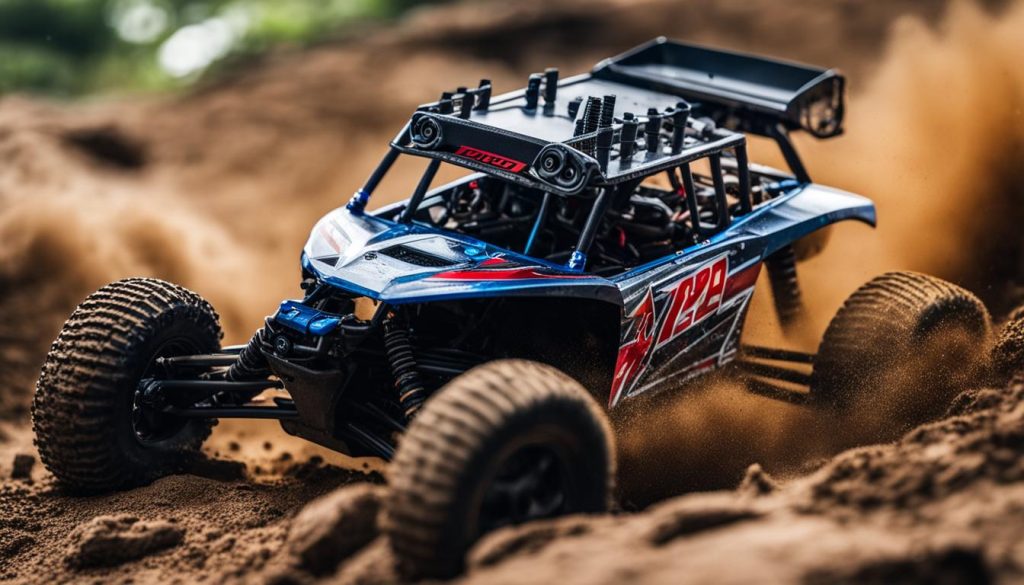
Conclusion
Upgrading the batteries in your off-road RC car is a simple and effective way to improve its performance and extend your driving time. By understanding the battery C rating, choosing the right battery type, considering capacity and voltage, and prioritizing safety, you can optimize your RC car’s battery performance.
Additionally, exploring motor upgrades like gearing down and brushless motor conversions can further enhance your off-road RC car’s overall power and longevity. By following these battery upgrade tips, you’ll be able to maximize the enjoyment of your off-road RC car adventures.
Remember, upgrading your batteries not only improves your RC car’s performance, but it also allows for longer drives and more excitement. So go ahead and take your off-road RC car experience to the next level with these battery upgrade tips.
FAQ
How can I upgrade my off-road RC car batteries?
To upgrade your off-road RC car batteries, you can follow these tips: understand battery C rating, choose the right battery type, consider battery capacity and voltage, upgrade to higher capacity batteries, ensure safety with battery upgrades, improve motor performance, and explore brushless motor upgrades.
What is battery C rating?
Battery C rating refers to how much current a battery can deliver in a given amount of time. A higher C rating means the battery can deliver more current, resulting in faster charging and increased power output for your RC car.
What are the types of batteries used in RC cars?
The two main types of batteries used in RC cars are NiMH (Nickel-Metal Hydride) and LiPo (Lithium Polymer). NiMH batteries are beginner-friendly, cheaper, and easier to charge and store. LiPo batteries offer higher performance, longer-lasting power, and a better weight-to-power ratio.
How do I choose the right battery type for my RC car?
You can check your RC car’s owner’s manual to determine which battery types are compatible. Consider upgrading to LiPo batteries for improved performance if your car allows it.
How does battery capacity and voltage affect my RC car?
Battery capacity, measured in milliampere-hours (mAh), determines how long the battery can power your RC car. Higher capacity batteries provide longer run times. Voltage, on the other hand, determines the power output and RPM of your RC car.
How can I upgrade to higher capacity batteries?
For NiMH batteries, you can find options with higher mAh ratings that provide extended power output. You can also consider converting to LiPo batteries, which offer even better performance and longer-lasting power.
What safety measures should I consider when upgrading my RC car batteries?
Some battery upgrades may require additional safety measures, such as a low voltage cutoff (LVC) to prevent over-discharging the battery. Consider installing external protection devices like LVC alarms or cutoffs to ensure safe and optimal battery performance.
How can I improve my RC car’s motor performance?
You can gear down your RC car by using a smaller pinion. This reduces strain on the motor and improves overall efficiency, resulting in better acceleration and longer motor life.
What are the benefits of exploring brushless motor upgrades?
Brushless motors offer higher power output, increased efficiency, and longer run times. They are also compatible with LiPo batteries, further enhancing the overall performance of your off-road RC car.
How can I improve my off-road RC car batteries?
By upgrading your batteries and considering motor improvements, you can enhance the performance and longevity of your off-road RC car. Follow these battery upgrade tips and enjoy longer drives and improved power.
Source Links
- https://www.towerhobbies.com/cars-and-trucks/parts-electronics-and-accessories/batteries/
- https://www.rcuniverse.com/forum/mrc-charger-product-support-i-e-super-brain-etc-478/11694919-can-i-use-higher-mah-batteries.html
- https://www.rctech.net/forum/electric-off-road/672049-7-4v-lipo-replacing-7-2v-nimh.html

